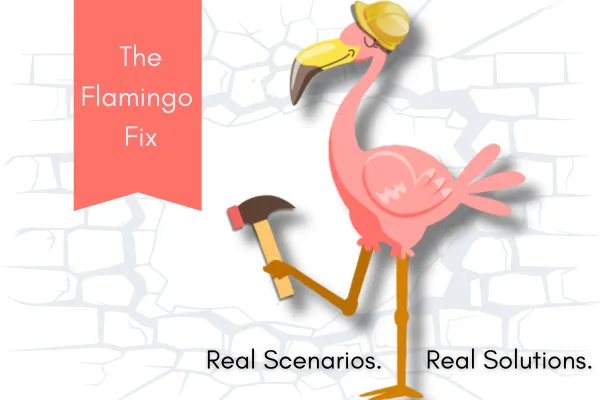Read the Blog!

Flamingo Fix 022: The $50K Communication Problem Every Service Business Has
The $50K Communication Problem Every Service Business Has
I was consulting with an established business leader dealing with constant boundary pushback around client communication protocols. She said, "These are clients that are going to get phased out anyway. If these were clients I'd want to retain long-term, this would be a huge problem."
She was exhausted from managing 30-50 daily messages outside her designated Slack system. Clients kept texting instead of using her established channels. Then her team members ended up monitoring two channels. Someone would periodically go through her texts so she didn't miss anything. Over two months, this cost her $50K in stress and energy.
She was planning to solve boundary violations by sticking it out and then finding different people instead of building systems that work with any people.
She was trapped in the false choice: endlessly correct them (grey: them-focused) or cycle through new clients hoping for better respect (grey: me-focused).
I asked her something that changed everything: "What if the same boundary issues emerge with your 'new and improved' clients... because the challenge isn't who you're attracting?"
The 3-Tier Communication System That Prevents Violations
🦩Your 5-Minute Pink Process Rescue
We advised her, the next time a client reaches out through the wrong channel, take these 3 steps.
STEP 1: Redirect them with this focus-on-them message:
"Thanks for reaching out! To ensure you get the fastest response and nothing gets lost in my DMs, please post this in our Slack channel. My team monitors Slack throughout the day, so you'll get a quicker answer there."
STEP 2: If they violate again: Wait 24 hours before responding. Give the same response.
STEP 3: Third violation: No response at all.
Steal this to handle your client communication violations today, if it feels safe for you and fair for everyone involved in your business. If it doesn't feel that way for you, we included some questions further down for you to create your 3-step communication boundary violation response plan).
Remember: This is not about being mean. It's about serving them AND you!)
🦩Case Study: From 50 Daily Violations to Zero in One Week
Within 2 days, people who kept messaging outside the designated channel started using the correct system. Same people. Different enforcement protocols.
She realized she didn't need to start over with new clients. She needed frameworks that transformed boundary testing into boundary respect. Her empowering reality:
Clients receive faster, better support through proper channels
Her team works efficiently without lost messages
She maintains clear boundaries while clients feel respected
Both she and her clients experience less frustration and better outcomes
🦩Long-Term Pink Solution: Communication Expectations Framework
Your long-term pink system: Overhaul your communication system with the three pillars of effective client communication:
Step 1: Expectation Setting:
During onboarding, clearly explain why your communication channel serves them better. "We use Slack because it keeps all project information organized where the whole team can access it, ensuring faster responses."
Step 2: Knowledge Transfer:
If you're requiring clients to use a communication tool, you onboard them into that tool well. Create a simple tutorial or walkthrough that highlights what is in it for them and how to use it to get what is in it for them. We've had clients who battled with low usage of their tools until they gave their clients a proper onboarding. Then those same clients become the tool's biggest advocate because they can finally track project progress easily.
Step 3: Clear Response Protocol:
Define exactly how you'll handle communication violations before they happen. Write your redirect script focusing on what's in it for them, and decide your 3-step violation response timeline (24-hour delay, then no response). Save these as templates so you can respond consistently without emotional decision-making in the moment. Incorporate it into your client fulfillment process so your team can enforce it consistently.
To design your 3-step violation response plan, ask yourself these key questions:
FIRST VIOLATION: What can I communicate that would feel safe for me and fair for all as a first corrective step? Remember - focus on what is in it for THEM, not you.
SECOND VIOLATION: How long can you wait to respond? That has to feel safe to you, fair to all involved - try to stretch yourself. Remember - you are reiterating the first message you gave them.
THIRD VIOLATION: What action can you actually implement? Try to stretch yourself.
This pink communication system works because it addresses the real barriers to compliance: clients need to understand the process, have the ability to use your tools, and experience consistent consequences that reinforce the value of following your system.
🦩Your Next Pink Steps
Same people. Different systems. Different results.
OPTION 1: Book a Pink Systems Intensive if you're ready to build your customized pink communication system in a day. Book Your Intensive Today →
OPTION 2: Get the Client Behavior Blueprint. Stop managing client dysfunction. Start leading through it. Start preventing it. Access the Blueprint Today →
OTHER OPTIONS:
1. Book a Curiosity Call today. We'd love to know what's going on with you. Let's collaboratively determine how we can equip you with processes that position you to be a leader who honors you AND your people: Schedule Your Call →
2. Get posts like this straight in your email. Subscribe to Pink Flamingo Fix →
Real expertise isn't following a roadmap perfectly—it's knowing when and how to adapt the map.




